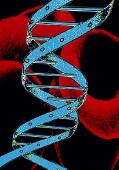
WEDNESDAY, Dec. 9 (HealthDay News) — A new method of testing for breast tumors might one day all but eliminate false positives and false negatives from breast cancer diagnosis, new research suggests.
Within the cell nucleus, chromosomes and individual genes occupy specific locations relative to one another. That organization can change for many reasons, but one of them is cancer.
Researchers from the U.S. National Cancer Institute have honed in on several genes that have a different physical position inside the nucleus in invasive breast cancer cells than in normal breast tissue cells. A change in the position of one gene in particular, HES5, predicted invasive breast cancer nearly all of the time, they found.
The discovery suggests that looking at three-dimensional properties of the cell could one day be used as a new method of diagnosing breast cancer.
“Our hope is that our method would be useful as an early marker,” said Tom Misteli, a cell biologist at the National Cancer Institute and the study’s lead author. “We know that the position of the gene changes before the activity changes. That is a very, very early event in the tumor formation.”
The study was published online Dec. 7 in the Journal of Cell Biology.
Typically, breast tumors are detected by a mammogram, which is basically an X-ray of the breast, or when a woman or her doctor feels a lump. To determine if the mass is cancerous or benign, a doctor would order a biopsy, which involves the removal of a small tissue sample that is then analyzed by a pathologist.
A pathologist looks at such factors as the shape and arrangement of cells to determine if a sample is cancerous. Some cancers are relatively easy to discern, said Dr. Victor Vogel, a breast cancer expert and the American Cancer Society’s national vice president for research. But a few cases are judgment calls that even the most experienced pathologist isn’t sure about, he said.
“It’s just not black and white all the time,” Vogel said.
Pathologists can have particular difficulty discerning the difference between non-cancerous hyperplasia, or an excess of cells, and ductal carcinoma in situ, a non-invasive and highly treatable form of breast cancer. At times it can be also difficult to tell the difference between ductal carcinoma in situ and invasive ductal carcinoma, a more aggressive and life threatening form of cancer.
“That’s why this paper is so important,” Vogel said. “What every pathologist and every patient wants is more diagnostic certainty.”
Using 11 normal human breast tissue samples and 14 invasive cancer tissue samples, the researchers identified eight genes that were frequently repositioned in cancer specimens. They found that the repositioning of the gene HES5 indicated breast cancer in nearly all samples.
Previous research had implicated HES5 with cancer, according to background information in the study. In the new study, the researchers also found that changes in the location of several other combinations of two or three genes also indicated cancer with high accuracy.
“If validated in a larger number of samples, we envision that this approach may be a useful first molecular indicator of cancer after an abnormal mammogram,” Misteli said. “Our method of cancer diagnosis is not limited to breast cancer and may be applied to any cancer type in which repositioned genes can be identified.”
The next step, he said, is to replicate the findings using more tissue samples. “We think this method will be used in combination with conventional methods [such as mammogram and biopsy] but will make detection a lot stronger.”
More information
The U.S. National Cancer Institute has more on breast cancer.

